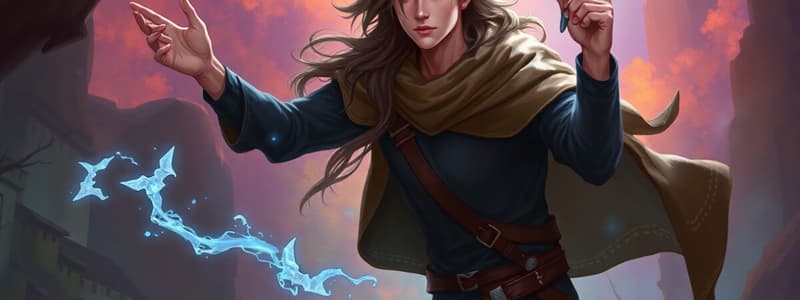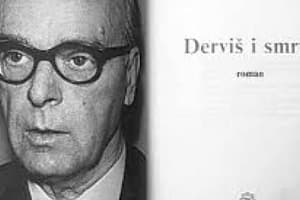Podcast
Questions and Answers
What perspective does a first-person point of view utilize in storytelling?
What perspective does a first-person point of view utilize in storytelling?
- The story is told from the perspective of a character using 'I' and 'me'. (correct)
- The narrator knows the thoughts of multiple characters.
- The character's thoughts are conveyed through an omniscient narrator.
- The narrator observes the characters without participating.
Which type of third-person point of view knows the thoughts and feelings of one specific character?
Which type of third-person point of view knows the thoughts and feelings of one specific character?
- Third-person limited (correct)
- Third-person omniscient
- Third-person reflective
- Third-person objective
What is the primary purpose of commercial fiction?
What is the primary purpose of commercial fiction?
- To provide a detailed analysis of real-life events.
- To provoke deep thought and philosophical questioning.
- To challenge societal norms.
- To entertain the audience. (correct)
What aspect is often conveyed through images and symbols in fictional writing?
What aspect is often conveyed through images and symbols in fictional writing?
Which of the following is NOT a characteristic of commercial fiction?
Which of the following is NOT a characteristic of commercial fiction?
What does the setting of a story refer to?
What does the setting of a story refer to?
What is true about dynamic characters?
What is true about dynamic characters?
What is the climax of a story?
What is the climax of a story?
How can the role of setting influence a story?
How can the role of setting influence a story?
Which element describes the organized pattern of events in a narrative?
Which element describes the organized pattern of events in a narrative?
What does an exposition in a story introduce?
What does an exposition in a story introduce?
Which of the following is NOT a characteristic used to analyze characters?
Which of the following is NOT a characteristic used to analyze characters?
Which element indicates the arrangement of events and actions in a story?
Which element indicates the arrangement of events and actions in a story?
What notable aspect of dialogue is present in contemporary drama?
What notable aspect of dialogue is present in contemporary drama?
How do contemporary playwrights often approach the structure of their works?
How do contemporary playwrights often approach the structure of their works?
What kind of characters and lives do contemporary dramas typically focus on?
What kind of characters and lives do contemporary dramas typically focus on?
What is a common goal of contemporary playwrights when creating their works?
What is a common goal of contemporary playwrights when creating their works?
What types of performances does contemporary drama encompass?
What types of performances does contemporary drama encompass?
What is characteristic of third-person omniscient narration?
What is characteristic of third-person omniscient narration?
What is the primary goal of literary fiction?
What is the primary goal of literary fiction?
How can one discover the theme of a story?
How can one discover the theme of a story?
Which is a trait of contemporary literature?
Which is a trait of contemporary literature?
What does magical realism blend in storytelling?
What does magical realism blend in storytelling?
What defines the theme in a literary work?
What defines the theme in a literary work?
What is the role of a literary writer compared to other types of writers?
What is the role of a literary writer compared to other types of writers?
What can the practical lesson derived from a story be defined as?
What can the practical lesson derived from a story be defined as?
What does the term 'tragic flaw' refer to in the context of the character described?
What does the term 'tragic flaw' refer to in the context of the character described?
Which of the following best defines 'farce'?
Which of the following best defines 'farce'?
What type of story does 'melodrama' typically represent?
What type of story does 'melodrama' typically represent?
In what form of drama is music and dance used alongside acting?
In what form of drama is music and dance used alongside acting?
What does Lt. Blanford's action of saluting and holding out the book symbolize?
What does Lt. Blanford's action of saluting and holding out the book symbolize?
What common characteristic is shared by characters in both farce and melodrama?
What common characteristic is shared by characters in both farce and melodrama?
In the narrative's climax, what does Lt. Blanford reveal to Miss Maynell?
In the narrative's climax, what does Lt. Blanford reveal to Miss Maynell?
How are the themes in a musical drama typically conveyed?
How are the themes in a musical drama typically conveyed?
Flashcards are hidden until you start studying
Study Notes
Fiction Elements
- Physical appearance: Influences character perception and may reveal personality traits.
- Thoughts and feelings: Provides insight into characters’ motivations.
- Interaction: Reveals relationships and dynamics between characters.
- Character development: Characters can be static (unchanging) or dynamic (transforming through experiences).
Setting
- Definition: Comprises the time and place where the narrative unfolds.
- Importance: Can significantly contribute to the plot and theme or serve as mere backdrop.
- Time period: Affects language, atmosphere, and social context of the story.
- External conflict: May arise from the character's environment.
Plot
- Definition: The organized sequence of events within a story.
- Components:
- Exposition: Introduces characters, setting, and conflict.
- Rising action: Events resulting from central conflict.
- Climax: The peak of tension or interest.
- Falling action: Resolution of conflict and easing of tension.
- Resolution: Conclusion of the story.
Point of View
- First-person POV: Character narrates the story, using "I" and "me".
- Third-person POV: An outside narrator tells the story; can be:
- Limited: Knows thoughts of a single character.
- Omniscient: Knows thoughts of all characters.
Theme
- Definition: Central message or main idea conveying the author's viewpoint about life or society.
- Analysis: Consider the broader message and moral lessons intended by the author.
Contemporary Literature
- Definition: Encompasses literary works from post-World War II to present, marked by distinct styles.
- Characteristics: Investigates pressing issues of modern society, including technology and globalization.
Magical Realism
- Definition: Blends realistic storytelling with fantastical elements, creating a sense of magic within the ordinary world.
Contemporary Drama
- Features:
- Realistic dialogue reflecting everyday life.
- Focus on ordinary characters and their experiences.
- Often challenges traditional narrative structures and audience expectations.
Genre Characteristics
- Farce: Nonsensical drama that emphasizes slapstick humor.
- Melodrama: Exaggerated emotional appeal, often featuring stereotypical characters.
- Musical drama: Combines acting, dialogue, music, and dance, capable of tackling serious subjects while entertaining.
Notable Works and Authors
- "Stop Kiss": A play by Diana Son, highlighting cultural identity and interpersonal relationships.
- Son's background: Korean-American playwright influenced by her immigrant parents; aims to explore life experiences through her writing.
Studying That Suits You
Use AI to generate personalized quizzes and flashcards to suit your learning preferences.




